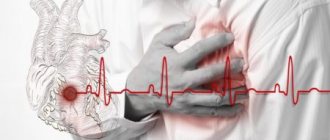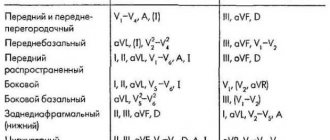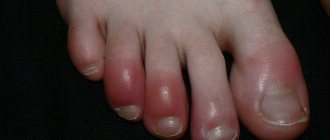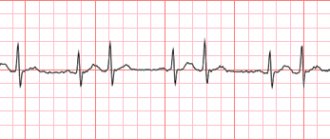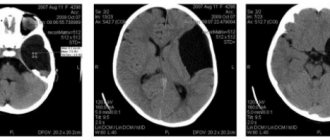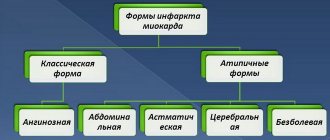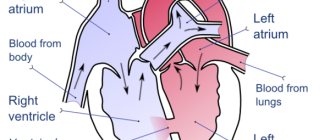Our organs and tissues need a constant supply of oxygen, nutrients and the removal of waste products. This is done through the blood supply system. Blood is “pumped” into organs and tissues through a “pump”, which is the heart. When the heart is healthy and the blood supply system is working properly, then all systems of the body also work in nominal mode. If our pump develops some kind of dysfunction, then the problems will not be local, cardiac, but global - the whole organism will “suffer” as a whole. Therefore, we can say that the heart is one of the most important human organs in everyday life, and even more so in sports practice, since the blood supply needs in sports increase significantly.
Signs of heart strain and its consequences
Dysfunctions of the heart are observed in most cases in the discrepancy between the amount of Oxygen it requires and the amount it receives. When the oxygen content decreases, it is no longer oxygen, but energy starvation. [1] The heart is not able to produce the required amount of ATP and, accordingly, is not able to carry out the required stroke volume of its work. The so-called cardiac overstrain, the symptoms of which will be:
- a sharp decrease in performance,
- weakness, increased sweating,
- shortness of breath, feeling that there is not enough oxygen, cough,
- rapid heartbeat, irregular heart rhythm (arrhythmia),
- chest pain, nausea, vomiting.
The general state of oxygen deficiency is called hypoxia. The causes of cardiac hypoxia can be various factors. In particular, in clinical practice, the most common diagnosis of cardiac hypoxia is myocardial ischemia, in which the lumen of the coronary vessels supplying the heart muscle decreases, and the cause of this condition in most cases is atherosclerosis of the arteries.
In sports practice, cardiac hypoxia occurs due to an increase in oxygen demand by all organs, primarily muscles. At the same time, the heart begins to experience oxygen deficiency, as a result of which cardiac functionality undergoes changes:
- Firstly, as mentioned above, the production of ATP molecules is reduced. In order to compensate for this dysfunction, the heart increases heart rate. Due to this, the amount of circulating blood increases and the amount of oxygen flowing through this blood also increases. However, heart rate has its own limit; for young and healthy athletes it is 200 beats/min, which is not recommended for other athletes. In addition, high heart rate is a state of cardiac overstrain, which must be clearly controlled in order to avoid irreparable pathological cardiac changes. [2] And this rule must be followed by all athletes, regardless of age and training.
“Secondly, the result of inadequate oxygen supply to tissues will be mitochondrial dysfunction, which will be manifested by phase fluctuations in the activity of mitochondrial enzymatic complexes. [2] This will lead to suppression of aerobic ATP synthesis. At the same time, the rate of formation of free radicals (FR) will increase, and the power of certain segments of the antioxidant system will decrease. A steadily increasing amount of reactive oxygen species (aka RO) and other toxic waste products will lead to the formation of oxidative stress, which is the cause of most cardiovascular diseases.
Types of sports heart
A sports heart can be classified according to the following indicators:
- How long ago the connective tissue was obtained;
- Volume of affected areas;
- Location of damaged areas.
On average, the classification is determined by the following table:
| Disability category | Recency of obtaining connective tissue | Volume of affected area | Location of damaged areas |
Possibility of surgical treatment
Cardiac pathologies resulting from overexertion
If the overstrain of the heart becomes chronic (permanent), then irreparable changes begin to occur in the heart, in particular:
DILATATION OF THE HEART CHAMBERS is a pathological condition accompanied by an increase in the volume of the heart chambers without changing the thickness of the heart wall. [2] Left atrial dilatation often results from a sustained increase in pressure in the systemic circulation due to chronic heavy physical activity. Dilatation is a factor in heart failure because the ejection fraction decreases due to stretching of the heart walls.
MYOCARDIAL HYPERTROPHY is a thickening of the muscles of one or another part of the heart. The most common cause is left ventricular hypertrophy. It occurs in athletes as a result of intense and prolonged physical activity and reflects an irrational path from adaptation to hyperfunction. [2] Cardiac dysfunction, as in the case of dilatation, occurs in a decrease in the ejection fraction, but the reason in this case is a decrease in the volume of the heart due to thickening of the walls. The next problem with hypertrophy is the deterioration of oxygen supply to the heart muscles. Firstly, an enlarged myocardium requires increased blood circulation, but the capillaries that provide increased blood flow develop much more slowly than the muscle cells of the heart.
Secondly, the diffusion time of oxygen from the capillaries to the center of the thickened muscle fiber increases, which leads to changes in oxygen consumption by the hypertrophied myocardium. As a result, lack of oxygen (hypoxia) leads to heart failure, overexertion and arrhythmia. [2]
Myocardial hypertrophy is one of the most common causes of death in sports. The share of such deaths is 33% of all deaths, taking into account non-cardiac (!) causes. [2] The collected statistics show that myocardial hypertrophy above certain values in deceased athletes occurs 17 times more often than in living ones.
ARRHYTHMIA. Normally, the heart beats in a certain rhythm, having in its cycle sequential contraction and relaxation of the atria and ventricles. If the frequency, rhythm or sequence of excitation and contraction of the heart is disturbed, then this is a state of cardiac dysfunction and is called arrhythmia. 15% of deaths due to cardiac dysfunction are associated with arrhythmia.
Athletes' diseases
All adaptive reactions increase athletic performance only under physiological training regimes. When playing professional sports, adaptation mechanisms often fail when the heart cannot withstand the overload. Similar pathological phenomena arise in situations where artificial stimulants - energy drinks and anabolic steroids - are used to achieve success in competitions.
Bradycardia
A decrease in heart rate is not always proof of good training. In about a third of athletes, low heart rate is accompanied by the following symptoms:
- performance decreases;
- increased loads are poorly tolerated;
- sleep is disturbed;
- appetite decreases;
- periodic dizziness and darkening of the eyes occur;
- breathing becomes difficult;
- there is a pressing pain in the chest;
- concentration decreases.
Such complaints often accompany overwork or infectious processes. Therefore, when the pulse rate decreases to 40 beats or less in one minute, it is necessary to conduct an examination of the heart and internal organs to identify possible pathological changes.
Hypertrophy
The formation of a thickened muscle layer is associated with a constant increase in the level of pressure inside the heart. This triggers increased formation of contractile proteins, and the heart mass increases. In the future, hypertrophy becomes the only way to adapt to increased sports loads. The consequences of increasing muscle volume manifest themselves in the form of such changes:
- the myocardium recovers poorly during diastole;
- the size of the atria increases;
- the excitability of the heart muscle increases;
- the conduction of impulses is disrupted.
All these factors provoke the development of various rhythm and systemic circulation disorders and the appearance of pain. With intense exercise, shortness of breath and a feeling of interruptions, dizziness, and chest pain occur. In severe cases, suffocation increases, which is a manifestation of cardiac asthma or pulmonary edema.
Arrhythmia
In heart rhythm disturbances, a significant place is given to the physiological increase in the tone of the parasympathetic nervous system, which is noted during intense sports. This provokes bradycardia, a slowdown in the conduction of impulses in the atrioventricular node, up to 1st or 2nd degree blockade.
Ventricular extrasystole is often detected. These changes most often occur with overtraining syndrome and reflect insufficient recovery of the heart muscle.
Long-term endurance loads can cause the development of atrial fibrillation, attacks of supraventricular and ventricular tachycardia. The clinical significance of arrhythmia increases many times over in the presence of congenital abnormalities in the structure and functioning of the conduction system of the heart. For example, the presence of Wolff-Parkinson-White syndromes or a long QT interval can cause sudden death.
Arterial hypotension
Increased parasympathetic tone leads to a decrease not only in heart rate, but also in peripheral arterial resistance, so blood pressure in athletes is lower than in untrained peers. However, most do not feel it, since during periods of exercise, blood circulation is activated - the minute and stroke volume of blood ejection increases. If compensatory mechanisms weaken, then changes in hemodynamics are not enough.
Deterioration in health may be associated with infection, arrhythmia, allergic reaction, injury, or dehydration. In such cases, fainting, short-term loss of vision, pale skin, unsteadiness when walking, and nausea occur. Severe cases can cause loss of consciousness.
Causes of heart strain in sports and methods of prevention
1. It is IMPORTANT to emphasize the main idea here: the main cause of chronic overstrain of the cardiovascular system (CVS) is physical activity of significant volume and intensity. [2] That is incorrect, “greedy” planning of training progress leads to cardiovascular pathology. In the context of bodybuilding, this takes on increased relevance! Due to the fact that one of the main goals of BB is mass gain, other systems of the body, especially the heart, simply do not keep up with the super-intensive growth of mass and in fact pathological adjustments of these organs to the inflated demands of mass appear. Numerous examples of deaths caused by the failure of the cardiovascular system, both among current bodybuilders and among former, but not yet old, bodybuilders, confirm this. Therefore, the main message of this point is that if the goal is to weigh a lot, then this must be done gradually, without extreme weight increases of tens of kilograms!
2. Illness, cold, flu, inflammation...training against the background of illness is strictly not recommended. [1,2] The adaptive forces of the body in such conditions are sharply reduced, oxidative stress is increased, and the load on the heart increases many times over. If you try to maintain training intensity against this background, it will be very easy to get cardiac overstrain. The best option is to take a break, lie down and “get sick.” As a last resort, the intensity of training should be sharply reduced - classes during this period should be considered only as physical therapy (physical therapy).
It is also necessary to strictly monitor chronic diseases. Sports medicine here pays attention to diseases of the oral cavity that can occur in an indirect form, such as tonsillitis, periodontitis, and root cysts. [2] Inflammatory factors from such foci can drain into the blood, reducing both immunity and the activity of myocardial antigens.
3. Psycho-emotional stress. The banal recommendation to be less nervous is, in fact, quite justified in its relevance. Information and communication stress, which creates the background for the development of psycho-emotional disorders, causes overstrain of the psyche and neuroendocrine system, thereby disrupting the regulation of the cardiovascular system. [2] The athlete’s exposure to any traumatic factors must be limited as much as possible.
4. Bad habits. In particular, smoking is one of the most common causes of coronary heart disease. It provokes vasospasm and thus increases blood pressure. The negative effect on the body increases many times over if it is combined with an increase in cholesterol in the blood.
5. Hypertension. This partly echoes the first point and a prerequisite for hypertrophy will be excess body weight. This pathology will be enhanced by problems of insufficient local (capillary) blood supply. Therefore, high-repetition approaches with light weights (such as the Cutting program), as well as cardio training, should be present in training programs to improve local blood supply to the muscles.
Preparations and vitamins for the myocardium
Athletes do not require specific treatment if they do not have:
- chest pain;
- interruptions in heart function;
- increased fatigue;
- fainting conditions;
- ECG changes – ischemia, arrhythmia, conduction disturbances.
In such cases, changes in the heart are considered physiological; the following drugs can be used to strengthen the myocardium:
- if myocardial hypertrophy predominates - ATP-Forte, Neoton, Espa-lipon, Carnitine, Cytochrome, with high blood pressure and tachycardia, beta blockers are prescribed - Egilok, Anaprilin;
- with predominant expansion of the heart cavities - Magne B6, Panangin, Rhythmocor, Mexidol, Methyluracil with folic acid, Riboxin, Potassium orotate, vitamin B12;
- vitamins - special multicomponent complexes for athletes (Optimen, Optivumen, Multipro, Supermulti), vitamin and mineral preparations (Supradin, Pharmaton, Oligovit);
- adaptogens – tincture of Leuzea, Rhodiola, hawthorn;
- food additives – Omega 3, Ubiquinone, Succinic acid.
If there are significant disturbances in the functioning of the heart, then these funds are not enough. With the development of pathological sports heart syndrome, complex treatment is carried out using antihypertensive, antiarrhythmic drugs, and cardiotonics.
Adaptation of the cardiovascular system to sports activities depends on the specifics of the training. During aerobic exercise, expansion of the chambers of the heart predominates, and during strength exercise, thickening of the myocardium predominates. At the same time, in all athletes, physiological parasympathicotonia causes a slowdown in rhythm, hypotension and reduced conductivity of cardiac impulses.
If you have complaints about your heart, you need to undergo a full examination, since overtraining can lead to illness. To increase resistance to physical activity, medications are used taking into account the type of sport and diagnostic results.
Source: CardioBook.ru
Medicines and dietary supplements for cardiac stress
To reduce the load on the heart and prevent its overstrain, sports pharmacology has a number of medications and dietary supplements, which can be conditionally divided into 4 main groups according to the vector of application of cardioprotection. Some of these drugs may have complex effects and be included in several groups.
1. Drugs that optimize ENERGY PROCESSES IN THE CELL.
These effects are inherent
1A. macroergic phosphates (creatine, riboxin, phosphadene, ATP-long)
1B. inhibitors of lipolytic processes (nicotinic acid, natural antioxidants ceruloplasmin and superoxide dismutase prototypes (panaxod, orgotein, peroxinorm),
1C. enzymes and electron-acceptor substances (D-ribose, cytochrome C, coenzyme Q10, L-carnitine, trimetazidine, meldonium, succinic acid (succinate)).
2. Drugs that increase the RESISTANCE OF CELL MEMBRANES. This is, in particular,
2A. phospholipids (essential), α-tocopherol (Vit.E), probucol, PUFAs (Omega-3-6), β-carotene (Vit.A))
2B. inhibitors of free radical processes (mexidol, flavin, quercetin, rutin, methionine, unithiol, epargriseovit),
2C. phospholipase blockers (cefaransine, chlorpromazine, calcium antagonists, etc.)
3. ANTIHYPOXANTS. These are the means
3A. Improving coronary blood flow and blood transport function. In particular, Arginine, Meldonium, Actovegin, Aerox Oxygen Drops
3B. Improving the processes of energy supply to the cell are the products of the mentioned group No. 1, Meldonium, Creatine, ATP-long, L-carnitine, succinic acid, etc.
4. Means for CORRECTING IONIC FLOWS. Primarily Potassium K+ and Magnesium Mg2+ ions, and the most famous drug here is Panangin (Asparkam)
Sport
I played one sport or another throughout my childhood and youth. Due to an injury, he was forced to take a long academic leave from sports for almost 15 years - from 20 to 33.
I decided that I needed to lose weight 2.5 years ago, and from 100 kg I brought my weight to the current 74 kg. I have been doing triathlon for three years now.
The first year was spent on general physical training. The second year was already more practical - a lot of cycling, running and the first competitions. But, due to a number of mistakes and fatal accidents, it was not possible to bring the results to the desired level.
I took advantage of the opportunity and devoted the off-season to what I had long wanted - basic things, without which, in my opinion, it is impossible to be healthy, stay in good shape for a long time without injuries, and show good results.
I got myself in physical and psychological order as follows: hot yoga, cycling at a low heart rate, deadlifts and squats with a barbell, barefoot running, running with my mouth closed and Total Immersion swimming - all these are things that directly affect heart rate .
Hot yoga (+40 degrees Celsius with 40% humidity) and CrossFit can be compared to interval training, during which high heart rates are often achieved in short periods. The rest, on the contrary, teaches the heart to work at low speeds. The combination of these two things gives the desired effect. For me personally, I consider the ability to breathe through the nose during these loads to be the basis.
In yoga, the entire lesson, with the exception of breathing warm-up, is done only through the nose. At CrossFit, in just 20 minutes of training, you get out of your comfort zone every time and get to know yourself from a new perspective. A well-executed WOD (Workout of the Day) usually ends with the participant lying on their back with their eyes wide open and their breathing and heart rate racing. But, at the same time, after 5 minutes you want more!
Running in winter is the best time for leisurely runs with your mouth closed! And if you also run on your toes, thus strengthening your feet, calves and ligaments, then you can’t think of anything better for your body.
Using a bicycle station at home is very convenient to monitor your breathing and practice long inhalations and exhalations.
Swimming using the “Total Immersion” method is aimed at low heart rates and enjoying every stroke; it teaches you not to fight the water. According to the books, I went from 21 strokes in a 25-meter pool to 13 strokes.
It’s still difficult to give exact figures about progress in heart rate zones, since I’m just getting into shape in connection with the start of the season. Therefore, I will focus on just a couple of observations.
First observation.
Last year, the resting heart rate on the ECG was 47 beats per minute. Yesterday, before getting on the bike station at home, standing up I saw the number 41 on the heart rate monitor. Then I lay down and saw the number 35-36 for 5 minutes, and then double-checked it manually :).
Second observation.
The pace of my running training is now constantly increasing in connection with the preparation plan for the Riga Marathon, and I am surprised by how quickly the progress is happening. I can run for a very long time at a high heart rate. At the same time, the pace increases quickly, and the heart rate remains at the same level for quite a long time. All this allows me to hope that in a couple of months I will be able to reap real benefits from the work I have done this winter.
The training system is simple:
- On average, in the off-season I devote 2 hours a day to sports: 2 workouts for an hour.
- One day - swimming and running.
- The next day is CrossFit and cycling.
I like to use my time wisely, so I did double workouts in the winter - running from home to work, and then from work to the pool. In the spring I rode my bike to work and home from work.
Description of bradycardia in athletes
Bradycardia in adolescent and adult athletes can be physiological or pathological. The first form is often found in healthy people and those involved in sports activities. According to statistics, about 25% of trained men experience a similar phenomenon. In medicine, pharmacological bradycardia is also distinguished. The reason for its development lies in the use of certain medications.
As for pathological bradycardia, it can occur in acute or chronic form. In addition, it is divided into extracardinal and intracardinal. In the first case, we are talking about disruption of the functioning of individual organs that can have an indirect effect on the activity of the heart muscle. The intracardial type is said to occur when cardiac pathology occurs.
The body of a healthy person quickly adapts to physical activity. When he constantly has to train, the blood supply and energy metabolism changes. Such transformations make it possible to maintain good performance under increased loads.
During training, the heart can expand, which is myocardial hypertrophy. Such changes are usually reversible, so after rest the rhythm is completely restored.
Depending on the type of activity, athletes' hearts differ in size. The largest is found among representatives of high-speed disciplines (cyclists, swimmers, skiers, runners). The volume of the heart muscle is somewhat smaller in wrestlers, football players, and hockey players. The hearts of athletes who lift weights or are simply involved in fitness usually do not undergo changes.
With adequate loads in the gym, the main organ of the circulatory system ensures the body's endurance and normal performance. In a calm state, the heart muscle uses resources sparingly and the heart rate is within 60 beats per minute. If a lower heart rate is observed in athletes, this indicates bradycardia. Their heart gets used to regular exercise, so even in the absence of training, it continues to contract intensively, actively pumping blood through the vessels.
